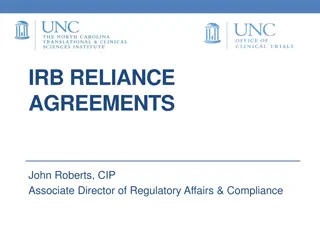Risks and Considerations in Joint Purchasing Agreements
Evaluating the potential risks associated with joint purchasing agreements, this review explores factors such as competition effects, buyer-seller relationships, and downstream impacts. It highlights the importance of distinguishing between buyer cartels and acceptable joint purchase agreements to ensure pro-competitive benefits outweigh any restrictive effects. Various scenarios where joint purchasing arrangements could lead to adverse outcomes are discussed, emphasizing the complexity of balancing upstream and downstream interests.
Download Presentation

Please find below an Image/Link to download the presentation.
The content on the website is provided AS IS for your information and personal use only. It may not be sold, licensed, or shared on other websites without obtaining consent from the author.If you encounter any issues during the download, it is possible that the publisher has removed the file from their server.
You are allowed to download the files provided on this website for personal or commercial use, subject to the condition that they are used lawfully. All files are the property of their respective owners.
The content on the website is provided AS IS for your information and personal use only. It may not be sold, licensed, or shared on other websites without obtaining consent from the author.
E N D
Presentation Transcript
Review Horizontal Cooperation Guidelines Joint purchasing (Ch.4) Giacomo Calzolari European University Institute EAGCPmeeting June 2022
Assessing a buyers agreement STEP 1 Checking restriction by object Does it implement hardcore restrictions : prohibited price-fixing, output limitation or market allocation? Does it involve to exchange of commercially sensitive information on individual purchasing intentions or negotiations, outside genuine joint bargaining agreements? STEP 2 Checking restriction by effect Has it most likely negative effects on competition upstream and /or downstream? STEP 3 If restrictions by effect, check 101(3) Has it likely pro-competitive benefits outweighing restrictive effects? STEP 4 Check for vertical restraints in any case (Vertical Block Exemption) 2
A tension Since Galbraith (1952): interests of downstream firms and final consumers seen as aligned, both parties prefer lower wholesale prices But many things could go wrong in this reasoning (long list) Hence, there is room to distinguish between buyer cartel (not acceptable), and joint purchase agreement (acceptable), with some tension 3
What can go wrong Lower w does not always imply lower p: Ungern-Sternberg (1996) Iozzi, Valletti (2014), Gaudin (2018), assuming upstream linear pricing Non-discrimination effect of alliance: Molina (2019) joint bargaining implies [?] same contractual terms for all and one fits all is not good if there is heterogeneity downstream Adverse upstream with variety reduction: Inderst et Shaffer (2007) buyers (no downstream competition) increase upstream competition by optimally committing to delist some upstream products, lower product variety, also Allain, Avignon and Chambolle (2020) Adverse downstream for non-member rivals: raising rivals cost (waterbed effect with increasing c as Inderst and Wey 2007, or Inderst Valletti 2011), reducing rivals benefit (curbing the upstream product), input foreclosure, weakening rivals bargaining position Facilitate downstream collusion: powerful buyer group may facilitate RPM/exclusivity with suppliers, or improved coordination of a cartel now using two instruments (w and p Piccolo and Mikl s-Thal (2012) and Doyle and Han (2014) 4
Trying to map consistency A consistency exercise on the proposed revised Guidelines, with eco academic literature 5
A key distinction Key in the distinction: buyer cartel has individual and covered activity/bargaining, joint purchasing agreement has joint/collective activity/bargaining 317 In a buyer cartel, purchasers coordinate their behaviour among themselves in view of their individual interaction with the supplier on the purchasing market. If purchasers deal individually with suppliers, they should make their own purchasing decisions independently of each other If collective bargaining, then coordinated decisions in principle could be ok (provided showing it allows to get better terms and ) What is the economic rationale for jointness being better? I appreciate the effort w.r.t. previous Guidelines, but I m still puzzled 6
A key distinction I appreciate the effort w.r.t. previous Guidelines, but I m still puzzled Difficult to solve this tension with wording and legalistic definition, Does the distinction individual/coordinated actions imply that making the agreement public (e.g. written) facilitates positive assessment? Why? If yes, why not state it negatively: if you do not have a written agreement it looks suspicious (not a notification, Macron law 2015) Make it transparent/public and easier for authorities to look into it if they want, with a by effects approach For a by effect approach, I would have expected a closer connection with Coordinated effects as in Horizontal merger guidelines After all, strong analogy with merger between buyer (although no direct effects of merger). So warnings if (i) downstream market sufficiently transparent to monitor deviations, (ii) conceivable credible punishment mechanism, (iii) difficult entry and or final buyers ability to prevent collusion 7
Markets definition Two relevant markets: Upstream & Downstream 327 Analyze them as usual (small but non-transitory price decrease), independently 329 However, for market power definition they are combined: However, in most cases it is unlikely that market power exists if the parties to the joint purchasing arrangement have a combined market share not exceeding 15% on the purchasing market or markets as well as a combined market share not exceeding 15% on the selling market or markets. Also, all examples deal with the combined up and down shares both above 15% Why an and , not an or ? Comparing with horizontal merger guidelines, 15% is a relatively tough standard, buyer alliances are similar to mergers (20%) except they do not (should not) imply downstream coordination 8
Theories of harm of joint agreements UPSTREAM Harming competition upstream which then spills over downstream 331. there is a risk that [buyers] may harm competition upstream For example may harm investment incentives and force suppliers to reduce the range or quality of products it is harming upstream indeed, clarify a broad notion of competition not just prices, also range and quality of products DOWNSTREAM 334. Foreclose competing purchasers by limiting their access to efficient suppliers Especially if limited number of suppliers and barriers to entry on supply Explicitly aiming at excluding an actual or potential competitor qualifies as a collective boycott and amounts to a restriction of competition by object. OK convincing, and not covered by coordinated effects of merger OK I appreciated no mention of waterbed effect : not convincing literature in this application [contd.] 9
Theories of harm of joint agreements DOWNSTREAM Reduced incentive for p-competition 335. First, if the parties together hold a significant degree of market power on the selling market or markets (which does not necessarily amount to dominance), the lower purchase prices achieved by the joint purchasing arrangement may be less likely to be passed on to consumers. BUT this has nothing to do with upstream joint purchasing, unless you presume they collude downstream as well (again coordinated effects ) 335. More upstream coordination may imply more downstream coordination , especially with clauses impeding buying elsewhere upstream or if it imposes exact quantities to each buyer Convincing as these clauses really point to downstream collusion, but should receive more emphasis as an independent point and go to collusion part [contd.] 10
Theories of harm of joint agreements 336. In the analysis of whether the parties to a joint purchasing arrangement have buying power, the number and intensity of links (for example, other purchasing agreements) between competitors in the purchasing market are relevant. Clarify links DOWNSTREAM: (Collusion) 341 more common(-value) cost issue simplifies downstream coordination (especially if large component) and also other information exchange (build Chinese walls on information, not fully convincing) and to be limited to the necessity for the agreement 352 Example The incentive for the parties to coordinate their behaviour would be reinforced if their cost structures were already similar prior to concluding the agreement. BUT not true that the incentives to coordinate are reinforced, coordination is easier to support 11
Assessment under 101 (3) 344 Joint purchasing arrangements can give rise to significant efficiency gains. In particular, they can lead to cost savings such as lower purchase prices or reduced transaction, transportation and storage costs, thereby facilitating economies of scale. BUT this is not necessarily efficiency gain How to activate efficiency gains? 1. Indespensability of restrictions included in the joint agreement just to activate efficiency gains 2. Pass-on-to consumers: necessary some of it, cost reduction not sufficient, but not only prices, check for quality and variety too 3. No elimination of competition: if there is up or down, then no 101 3 12
Review Horizontal Cooperation Guidelines Joint purchasing (Ch.4) Giacomo Calzolari European University Institute EAGCPmeeting June 2022























